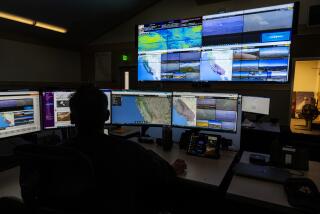NASA and the U.S. Forest Service team up to design better fire shelters
Reporting from HAMPTON, Va. — When 19 Granite Mountain Hotshots were trapped by a raging wildfire in Arizona in 2013 and died inside their emergency shelters, Mary Beth Wusk took notice.
Then she took action.
A materials expert at NASA Langley Research Center here, Wusk and her team develop new flexible heat shield technologies for spacecraft that must withstand blistering thermal loads on reentry.
“I talked to the team: Is there any chance that we can take the technology that we’re developing for the heat shields and transfer them to an application for the fire shelters for entrapment situations?” Wusk recalled recently.
They reached out to the U.S. Forest Service, whose National Technology and Development Center also was working on a fast-tracked redesign of its shelters after the Arizona wildfire tragedy.
“It was a welcome inquiry from NASA,” said Anthony Petrilli, a fire shelter project leader with the Forest Service center in Missoula, Mont. “I knew it would be a great entity to extract some technology and some materials and just some intelligence from, that’s for sure.”
Now the two agencies are teaming up to incorporate next-generation space technologies into emergency shelters in an effort to better protect firefighters.
Since the 1960s, Petrilli said, emergency shelters have saved the lives of more than 350 firefighters. In 1994, outside Glenwood Springs, Colo., he said, he deployed one himself in a burned-out area to escape heavy smoke and a big ember shower.
According to Forest Service guidelines, shelters must be rapidly deployable: unfold, “shake out,” climb inside and lie flat.
They must be portable, which means as lightweight as possible, ideally about 4 pounds, since firefighters are required to lug them around along with about 40 pounds of other essential gear while they operate for days and weeks at a time in hot, difficult and dangerous terrain.
And, just as critically, the shelters must be cost-effective. It’s no easy task.
“We couldn’t just take a flexible heat shield material and literally stick it to a fire shelter template,” said Josh Fody, a thermal analyst at NASA Langley. “So we began developing our own lighter, thinner insulations that were more targeted for the fire shelter applications.”
The current fire shelter used by the Forest Service was introduced in 2003, and, at the time, represented the best available combination of design and materials.
It’s made up of two layers: an outer layer of woven silica laminated to aluminum foil to reflect radiant heat and slow any heat transfer to the inside, and an inner layer of fiberglass laminated to aluminum foil to keep out re-radiated heat and toxic gases. It’s shaped like a long half-cylinder with rounded ends.
The shelter works well in radiant heat situations, or when it’s not in direct contact with flames, Petrilli said. But it’s much less effective with convective heat, when flames contact the shelter directly.
For that reason, firefighters are trained to deploy shelters in areas that are clear of fuels that can feed a fire, and away from steep slopes and draws.
It was convective heat, Petrilli said, that doomed the Granite Mountain crew battling the fire near Yarnell, Ariz.
“There was just heavy brush in the area,” Petrilli said. “Firefighters were not able to find a large enough clearing.” He added that 50-mph winds were “pushing flames pretty much parallel to the ground.” In nonscientific terms, he said, there was “a ton of red-flame contact.”
The original Forest Service timeline called for a product review of its emergency shelter system beginning in 2015 to identify any possible improvements in materials, design or training. But that timeline was stepped up by a year after the Yarnell Hill fire.
To help with the effort, the NASA Langley specialists screened about 200 sample materials, then presented the most feasible to Petrilli’s team, which has been working on its own designs.
They call their partnership Convective Heating for Improvement for Emergency Fire Shelters, or CHIEFS. Fody is the team leader.
This summer, the team joined with the University of Alberta in Canada to conduct real-fire tests on 22 full-scale shelter prototypes in a remote region of Canada’s Northwest Territories.
The 22 shelters represent nine distinct designs, Fody said. Eight of the shelters were NASA Langley’s, representing four designs, built by S.D. Miller and Associates PLLC in Flagstaff, Ariz.
One of those designs had the same shape and weight as the current shelter, while one weighed a bit more. A third is more like a thermal pod: a stockier, shorter structure that would require less surface area and thus could be made of a heavier, more protective material.
The fourth design, Wusk said, was a heavier, tougher shelter that could be stored in a truck rather than carried by a firefighter.
The researchers will meet this month to go over the test results and to make plans for more tests in April.
“We all want to work together to make sure we’re getting the best product,” Wusk said. “This is something that’s changing people’s lives.”
The fire shelter project is expected to finish up in 2018.






